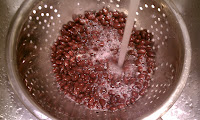We are back in the garden now with a brief overview of cold frames and of my recent cold frame building experience (see photo below). I was hoping to get this cold frame built last fall, but early Carolina cold spells stopped my fall season short. So of course, the first sunny day of this February, I was out in the front yard digging. One good day of digging and drilling will hopefully give me a big jump start on my spring (and later summer) gardens. Can you tell I'm in a hurry to get started this season?
What is a cold frame?
A cold frame is basically a wooden box with some kind of clear glass or plastic on the top. Some people even build them out of straw or hay bales rather than out of lumber.
Why use a cold frame?
Using a cold frame allows you to extend your gardening season in several ways. In the fall, you can plant root vegetables and hardy greens for harvesting throughout winter, and in spring, you can harden off plants in it earlier than frosts would allow directly in the garden.
How does it work?
The glass allows the sunlight and warmth to come in through the top. That warmth and warmth from the ground is trapped in the frame enough to raise the temperature inside the frame, protecting plants from frost, even late into fall and winter and early in the spring.
How did I build mine?
My cold frame is a fairly make-shift version with minimal investments in new supplies (big surprise), but I'm very pleased with the final result. I'm not going to get very technical here with dimensions and technique because honestly, I didn't get that technical when building it.
-
Materials: I had some scrap lumber discovered in the back yard, some wood screws bummed off of my constructionally-inclined roommate, and a couple of great old windows purchased at the
Scrap Exchange, a reuse material store in Durham for those of you in the area.
-Frame construction: The wooden frame was just built by constructing my scrap wood into a rectangle and attaching the boards with the wood screws using a power drill.
-Putting it all together: From there, I used an edging shovel to outline the wooden rectangle in the yard where I wanted my frame, then dug out a rectangular hole in the ground about 10 inches deep. The wooden frame was then placed on top of the newly dug whole, and the excess dirt built up around it to eliminate any gaps between frame and ground. Finally, my windows are just laid on top of the frame for now. I may add hinges later, but for now, this is working just fine.
Important note: Cold frames are often just laid on top of the ground at ground-level rather than dug into the ground. Digging the frames into the ground to the depth of mine can risk flooding after big rains or melting snows, particularly if your frame is at a low point in the yard. However, I chose to dig my frame into the ground to this depth to add the height needed to place larger seedlings in it without having to purchase extra wood to build my cold frame taller. I don't foresee much of a flooding risk, as my frame is at a high point in the yard, and we don't get a lot of big melt outs here.
Finished Product!
Below you can see the frame open with many early spring seedlings in there being hardened off before heading out to the garden. By being out in the cooler temperatures of the cold frame between the warmth of the indoor grow lights and the chill of the open garden, they should be much more hardy and resistant to cold spells once out in the garden. Before transitioning the seedlings from cold frame to the garden, I like to let them set out during the day for a couple days (as you can see in the first picture above).
Also inside you can see that I have placed some old broken mirrors around them to reflect more sunlight onto the plants as well. Finally, I encountered a few large tree roots in my digging, which, for now at least, are happily coexisting with my seedlings.
Alternatives to cold frames?
If you want something more serious, a greenhouse is always an option. But if you are looking for ways to get your plants out a little early with something simple and inexpensive/free, try just covering plants with makeshift
cloches. Instead of purchasing expensive (yet admittedly more attractive) glass cloches, try using clear plastic bottles with the bottom cut off to secure around your newly-planted tender seedlings while frost is still a risk.


























